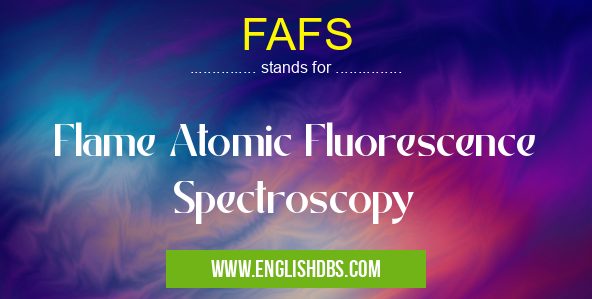What does FAFS mean in UNCLASSIFIED
Flame Atomic Fluorescence Spectroscopy (FAFS) is a highly sensitive analytical technique used to determine the concentration of specific elements in a sample. It is based on the principle that when atoms of an element are excited by a flame, they emit fluorescence radiation that is characteristic of that element.

FAFS meaning in Unclassified in Miscellaneous
FAFS mostly used in an acronym Unclassified in Category Miscellaneous that means Flame Atomic Fluorescence Spectroscopy
Shorthand: FAFS,
Full Form: Flame Atomic Fluorescence Spectroscopy
For more information of "Flame Atomic Fluorescence Spectroscopy", see the section below.
How FAFS Works
In FAFS, a sample is introduced into a flame, where the atoms of the element of interest are excited by the thermal energy of the flame. These excited atoms then emit fluorescence radiation at specific wavelengths. The intensity of the fluorescence radiation is directly proportional to the concentration of the element in the sample.
Advantages of FAFS
- High Sensitivity: FAFS offers excellent sensitivity, allowing for the detection of very low concentrations of elements.
- Selectivity: The technique is highly selective, as it can distinguish between different elements based on their specific fluorescence wavelengths.
- Versatility: FAFS can be used to analyze a wide variety of samples, including liquids, solids, and gases.
- Rapid Analysis: The analysis time for FAFS is relatively short, making it suitable for routine applications.
Applications of FAFS
FAFS is widely used in various fields, including:
- Environmental monitoring: Measuring trace metals in water, soil, and air
- Food safety: Determining the presence of heavy metals in food and beverages
- Medical diagnostics: Analyzing blood and urine samples for trace elements
- Geochemistry: Studying the distribution of elements in rocks and minerals
- Industrial chemistry: Monitoring process streams for impurities
Essential Questions and Answers on Flame Atomic Fluorescence Spectroscopy in "MISCELLANEOUS»UNFILED"
What is Flame Atomic Fluorescence Spectroscopy (FAFS)?
FAFS is an analytical technique used to determine the concentration of specific elements in a sample. It utilizes a flame to excite atoms of the target element, causing them to emit fluorescent light that is detected and measured.
What types of samples can be analyzed using FAFS?
FAFS can be used to analyze a wide variety of samples, including liquids, solids, and gases. It is commonly used for environmental monitoring, food analysis, and clinical diagnostics.
What are the advantages of using FAFS?
FAFS offers several advantages over other analytical techniques, including:
- High sensitivity and selectivity
- Wide linear range
- Rapid and simple analysis
- Minimal sample preparation
What are the limitations of FAFS?
FAFS is limited in its ability to analyze elements that do not form stable monatomic species in a flame. Additionally, it can be affected by matrix effects and interferences from other elements.
What are the applications of FAFS?
FAFS has numerous applications across various fields, including:
- Environmental analysis (e.g., monitoring heavy metal pollution)
- Food analysis (e.g., determining mineral content)
- Clinical diagnostics (e.g., measuring trace elements in blood)
- Industrial analysis (e.g., quality control of materials)
What is the difference between FAFS and AAS (Atomic Absorption Spectroscopy)?
Both FAFS and AAS are analytical techniques used to determine elemental concentrations. However, they differ in the way they measure the analyte signal. FAFS measures the fluorescence emitted by excited atoms, while AAS measures the absorption of light by atoms in the ground state.
Final Words: Flame Atomic Fluorescence Spectroscopy (FAFS) is a powerful analytical technique that offers high sensitivity, selectivity, and versatility. Its applications span a wide range of fields, making it a valuable tool for elemental analysis.
